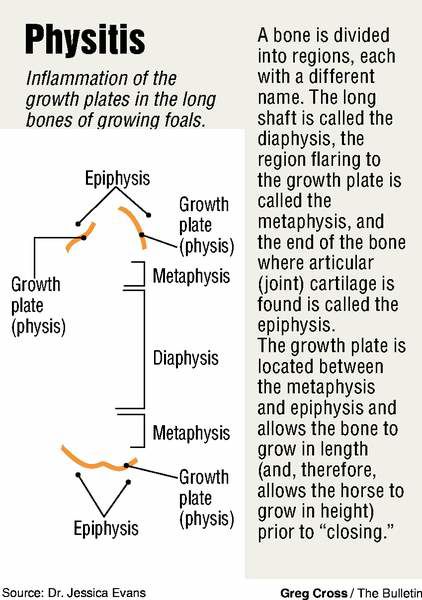Watch foals for signs of physitis
Published 5:00 am Friday, August 29, 2008

- Watch foals for signs of physitis
An array of orthopedic diseases can developed by foals during that important first year of life. Among those diseases is physitis, an inflammation of the growth plates in the long bones of growing foals (“physis” for “growth plate,” “itis” for “inflammation). To help understand this disease better, let me first describe how bones grow and the growth plate’s role in the process.
In the uterus, the skeleton of a foal is composed of cartilage. This cartilage gradually turns to bone as the fetus matures (a process called endochondral ossification).
Trending
When the foal is born, the majority of its bones have ossified (turned to bone), leaving cartilage at the site of the growth plate to allow further growth in length while the bony matrix provides support to the weight-bearing foal (see image).
The growth plates on each bone close (or ossify) at different times, but they are all closed by about 1 12 years of age. Prior to closure, though, problems such as physitis can arise at the growth plate.
When a foal develops physitis, it usually occurs in only one or two bones. Most commonly, the bones affected are the lower radius (just above the knee), the lower metacarpus or metatarsus (cannon bones), and the lower tibia (just above the hock).
The foals can be quite lame or just appear stiffer in the affected leg. Sometimes the signs are more subtle, such as the foal not running as much as other foals in your herd. Typically, swelling will be seen directly over the area of the growth plate, and the swollen area feel warm to the touch and be painful to the foal.
Diagnosis is made by physical examination and radiographic examination. It is important to rule out other causes for lameness in foals, such as infected joints, osteochondrosis (OCD) lesions, and flexural or angular limb deformities. A growth plate can become inflamed secondary to a bacterial infection, too, so it is important to rule out an infectious cause!
So what causes physitis? Research has found several causes, the most important being nutrition. Foals most commonly develop problems when they are fed excess nutrients, which allows for rapid growth. In most instances, foals grow at an appropriate rate with just their mother’s milk and hay. Grain is rarely necessary, so always be sure to consult with a veterinarian before placing your foal on a high-energy diet.
Trending
Nutrient deficiency (aka a-grocery-osis) can also cause problems. Another cause is trauma to or excessive weight bearing on a certain growth plate. Uneven weight bearing can be due to angular limb deformities or flexural limb deformity.
Infection is also a cause of physitis (from an external wound or infection spread from the foal’s bloodstream).
Treatment of physitis is usually conservative, and the inflammation will typically resolve on its own (as soon as the growth plates close, there is no chance of your foal developing physitis).
This does not mean we can ignore this disease, though, because your foal can develop problems secondary to the pain associated with physitis (angular or flexural limb deformities), and, depending on the cause, it may be a sign that your foal could develop more severe orthopedic diseases, such as OCD lesions.
Decreasing the plane of nutrition and restricting exercise will typically be helpful. Nonsteroidal anti-inflammatory drugs, such as Bute, can help decrease pain and inflammation, but be sure to contact a veterinarian before administering — these drugs can cause significant problems in a foal if used incorrectly!
Balanced trimming to the hooves is important as well. And, of course, if there is an infectious component to the physitis, antibiotics and further supportive therapy will be important for resolution.








